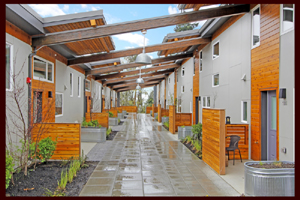Housing on the Warm Springs Reservation, as in many areas of Indian Country, is an essential need in short supply. An important first step in addressing the need is engagement of the community in finding a solution.
Marissa Ahern is a recent graduate of the University of Colorado, where she studied Environmental Design in the Architecture program. She graduated Magna Cum Laude with Honors. Her thesis paper was Tribal Housing on the Warm Springs Indian Reservation.
In a class of 175, her thesis was one of only five successfully defended, earning the Magna Cum Laude honor. Next year she begins the Penn State University Master’s Degree program in Community and Economic Development.
Working on her thesis, Ms. Ahern spent time with the Warm Springs Housing Authority, studying the state of housing on the reservation. In a thesis summary she says:
“The Confederated Tribes of Warm Springs is at a crucial point in its history, where critical planning must take place to address the tribe’s current housing conditions. There is a large shortage of housing on the reservation, with a current waitlist of over 300 families.”
The demographics of the tribe are adding to the situation: “Of the 3,175 people living on the reservation, 40 percent of the population is 19 years old or younger, and 62 percent of the population is 34 years or younger.
“This means the tribe can expect an increased demand for housing in the coming years, due to the high percentage of young tribal members who will be coming to the age of needing a home at the same time. The demand will be arguably impossible to meet without a serious commitment from the tribe to start addressing housing issues now.”
Ms. Ahern discussed this last week with the Tribal Council. Housing for Indians living at the Columbia River was another point of discussion, as BIA deputy regional director Bodie Shaw was also at the Council meeting.
The most important early element in developing new tribal housing is involvement of the community in the planning process. The active involvement of the community gives the people the vested interest leading to successful new housing, Ms. Ahern said.
For her thesis she visited and studied three housing projects across Indian Country: The Place of Hidden Waters on the Puyallup Reservation in Tacoma; the Sale River Heights project on the Makah Indian Reservation; and the Thunder Valley project on the Pine Ridge Reservation, South Dakota.
Aspects of the projects can serve as examples for Warm Springs, she said. The Hidden Waters development happened through a Housing Authority, similar to that of Warm Springs. So the financing component could be an example.
Tacoma is an urban area, though; so in terms of physical setting, the Thunder Valley project would be an example.
A lesson from all three projects is the engagement of the community during planning and actual construction. Engagement and empowerment of young people in the process is especially important, as in time they will be the ones living there.
Another important point: The design and construction should be culturally responsive to the community. To achieve this, engagement of the residents, instead of just informing them of decisions, is a key to success, Ms. Ahern said.
Through her thesis, she developed five guiding principles. “The objective for the guiding principles is to positively influence future planning efforts on the Warm Springs Reservation, specifically in regards to future housing projects.”
As a tribal member, she felt a personal responsibility to make the thesis as genuine and realistic as possible, so it can benefit the tribe in future planning of housing projects. In short the guiding principles are:
Facilitate a big picture vision. Respect the culture of the tribe. Community involvement. Understanding policy and resources. Finding Balance.
The timeline for successful planning can be a matter of years, in order to find a plan that everyone agrees would be best. For her part in the future, Ms. Ahern wants to continue working with the Confederated Tribes on housing development, starting with community engagement.
Her report was well received at Tribal Council and by the BIA, who have been working with the Corps of Engineers on a long-standing issue of Columbia River Indian housing.


